Importance of ‘Carabao’ Mango
The mango industry with 2.5 million farmers, is one of the backbone industries of the country’s agriculture sector. The mango variety ‘Carabao’ is one of our most important export products (EMB, 2015) and ranks third in terms of volume (885,000 metric tons) of production and area (188,100 hectares) next to banana and pineapple (PSA, 2015). It is known in the international market as the ‘Manila Super’ mango and considered as one of the best varieties in the world.
Industry Problems
‘Carabao’ mango has a very high potential for export be it in fresh or processed form. However, industry problems become a limitation on its performance in the international market. For instance, the declining yield and quality are attributed to pests and diseases, poor nutrient and water management, low adoption of improved technologies, and high postharvest losses. Other industry problems include difficulty in farm operations because of the large size of the ‘Carabao’ mango tree, non-assurance that planting materials sold in nurseries are true-to-type ‘Carabao’ mango, and high cost of production due to inefficient pesticide application. Beyond all these, there are policy issues and concerns that impede the advancement of the mango industry.
DOST-PCAARRD’s ISP for Mango
To address the industry problems, the Department of Science and Technology - Philippine Council for Agriculture, Aquatic and Natural Resources Research and Development (DOST – PCAARRD) crafted the Industry Strategic S&T Program (ISP) for mango in 2012. The ISP for mango aims to increase yield by 158% (5.82 mt/ha to 15 mt/ha); reduce postharvest losses by 65% (from 40% to 14%); and enhance capability of mango growers on Integrated Crop Management (ICM), Postharvest Quality Management (PQM), and Good Agricultural Practices (GAP).
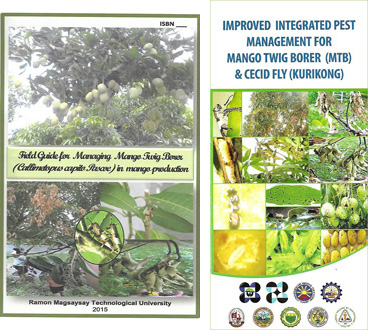
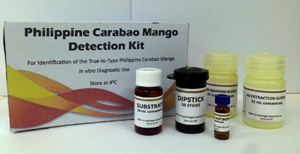
Through the DOST-PCAARRD’s National S&T Program for ‘Carabao’ Mango, IEC materials on enhanced integrated pest management (IPM) for the management of mango twig borer (MTB) and cecid fly or “kurikong”, two of the most serious insect pests of mango, were developed by the Ramon Magsaysay Technological University (RMTU). Suitability and vulnerability maps on mango production of Western Visayas are now available through a project on Geographic Information System (GIS) implemented by the University of the Philippines in the Visayas (UPV). In the area of plant breeding, putative mango hybrids with target traits such as red blush and thick skin, and resistance to pests and diseases were identified by the Institute of Plant Breeding of the University of the Philippines Los Baños (IPB-UPLB). Further, there is now assurance with quality planting materials since the Visayas State University (VSU) in collaboration with the University of Southern Mindanao (USM) developed a diagnostic kit for identification of true-to-type ‘Carabao’ mango.
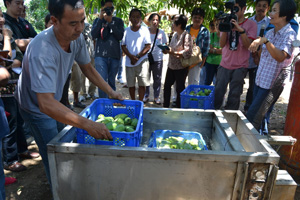
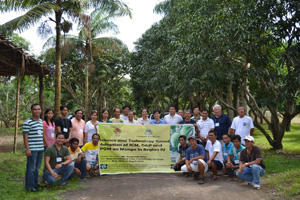
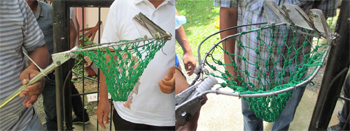
In the program Advancing the Philippine Mango Industry: Production of Export Quality Mangoes led by UPLB, 17 clusters of mango growers were organized in Regions I, II, III, IVa, VI and XII. More than 120 cluster members were trained on mango ICM, GAP, and PQM to expand the supply base of good quality mango fruits for domestic and export markets. This resulted in 42% increase in yield of cluster members. Another project in this program, implemented by the University of Southeastern Philippines (USeP), was the development of pre- and postharvest equipment such as mechanical fruit picker, low-volume power sprayer, and model integrated postharvest facility.
An ongoing program titled, Enhancing Competitiveness of Philippine ‘Carabao’ Mango through Varietal Improvement Program led by IPB-UPLB, aims to identify molecular markers associated with red blush, thick peel, and resistance to fruit fly and anthracnose through the genotype by sequencing (GBS) technology, and develop hybrids with these target traits. It is with high hopes that with this program, we will have another competitive variety for domestic and export markets in the future.
Valuable outputs from the completed and ongoing programs will benefit the industry, and ultimately the livelihood of our mango farmers through S&T interventions.
References
Briones, R.M., et al. 2013. FAO Commodity and Trade Policy Research Working Paper No. 42: Market Structure and Distribution of Benefits from Agricultural Exports: The Case of the Philippine Mango Industry. Food and Agriculture Organization of the United Nations.
Export Marketing Bureau (EMB). 2015. Philippine Export Guidebook. 2015 ed. Export Marketing Bureau, Makati City, Philippines. 95 p.
Philippine Statistics Authority (PSA). 2015. Selected Statistics on Agriculture 2015. ISSN-2012-0362. PSA. Diliman, Quezon City.
